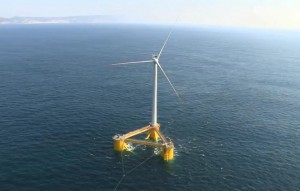A demonstration project received approval from the federal government, though Europe is still likely to see the new disruptive floating wind technology first.
The Bureau of Ocean Energy Management (BOAM) has given the go-ahead for Seattle-based renewable energy developer Principle Power to test its floating offshore wind technology on 15 square miles on the Oregon coast. WindFloat Pacific Project, Principle Power’s 30-megawatt offshore wind farm, will consist of five units tethered 16 nautical miles from Coos Bay, sitting1,400 feet above the ocean floor. That’s according to an article in Scientific American.
The National Renewable Energy Laboratory estimates that the West Coast is capable of producing more than 800 gigawatts of wind energy, however because waters off the Washignton, Oregon and California coastline are so deep, it’s challenging to pound in the monopiles necessary to support traditional offshore wind turbines. That’s one reason why Principle Power sees Europe as a more lucrative market, at least in the short run.
Principle Power’s first WindFloat unit was deployed in Europe in 2012, a 2-megawatt turbine located off the coast of Aguçadoura, Portugal. The company is backed by Spanish oil producer Repsol SA.
Principle’s disruptive floating wind turbine technology is decoupled form the ocean floor, significantly reducing the environmental effects of deployment and causing little harm to the sea floor, according to co-founder and director Craig Andrus. The company was founded in 2007 and received $2.3 million in seed funding from global angel investing network, Keiretsu Forum, in 2008.
If the WindFloat test is successful and the project moves forward, it would be the sixth offshore wind lease issued by BOEM and would likely be the first wind farm constructed on the West Coast. Principle Power hopes to have the units deployed by 2017, at a cost of about $200 million.

Other Floating Wind Projects
Other floating wind turbine developers include Statoil’s Hywind, the first floating wind turbine which has been testing their turbines off the coast of Norway since 2009 and recently got the go ahead to build at 30MW project 25 kilometers off the coast of Scotland in December.
In October, Spain introduced its first offshore wind turbine, despite a decrease in government subsidies. The five megawatt turbine, measuring 505 feet tall with 205 foot long blades, can satisfy yearly energy needs for 7,500 homes.
And Japan plans to build floating windmills off the coast of Fukushima. The country’s goal is to generate 1GW from 140 offshore wind turbines by 2020, utilizing its abundant coastline resources, according to the New York Times.
The Japanese government is funding the first three turbines to the tune of $224 million, and then a coalition of 11 companies plans to commercialize the project, including Hitachi, Mitsubishi Heavy Industries, Shimizu and Marubeni.
To read the full Scientific American story, click here
To read more about Principle Power on Bloomberg, click here